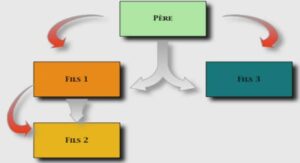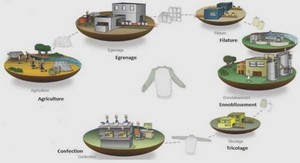Le déterminisme sexuel de l’huître crassostrea gigas
Weight and growth of oysters sexed each year from year 1 to year 6
The mean individual weight for oysters sexed each year according to their first sex at year 1 and the number of sex change are reported in Fig. 4. At the end of the study, the final weight was 71.8g for true females (i.e. no sex change from years 1 to 6) and 65.1g for true males with significant differences from year 2 to year 6 (Fig. 4a). For the protandric and the protogynic oysters (i.e. one sex change), the protandric oysters had significant higher weight than protogynic oysters from year 3 to year 6 ending to 73.3g and 64.2g, respectively (Fig. 4b). For oysters changing sex twice; males and females at year 1 had a similar final individual weight reaching 70.8g and 69.0g, respectively (Fig. 4c). Finally, among oysters that subsequently had three sex changes, males at year 1 were significantly heavier than those that were females at year 1, since year 3, ending respectively at 71.8g and 60.5g (Fig. 4d). A significant interaction between the sex at year 1 and the number of sex change was found for the gain of weight between year 1 and year 6 (P < 0.0001). Within sex at year 1, significant difference of growth was observed for females with the highest growth for oysters that had 0 and 2 sex changes, intermediate for those showing one sex change, while those having 3 sex changes had the lowest growth (P < 0.0001) (Fig. 5). For the oysters sexed males at year 1, oysters that never changed sex during the study showed a significant lowest growth than those exhibiting 1, 2, and 3 sex changes (P < 0.01) (Fig.5). Within sex change, males and females at year 1 that had two sex changes during the study showed a similar growth (P = 0.82), while females had a significant higher weight gain than males when they did not exhibit a sex change during the study (Fig. 5). In contrast, males at year 1 showed a significant higher growth than females at year 1 when oysters had one and three sex changes throughout the study (Fig. 5). Regarding the growth for the shell length between year 2 and year 6, a significant interaction between sex at year 1 and the number of sex change was found (P < 0.01). Within sex at year 1, a significant difference of growth was observed for females (P < 0.01) while it was not significant for males (P = 0.051). For the females at year 1, the highest shell growth was 60 observed for oysters showing 0 and 2 sex changes (14.8 and 15.5mm, respectively), while it was 12.5 and 13,5mm for those having 3 and 1 sex change, respectively (Fig. 6). The opposite trend was found for males at year 1, with the best shell length growth for individuals having 1 and 3 sex changes (17.6 and 17.1mm, respectively) and the lowest for the ones with 0 and 2 sex changes (15.5 and 16.1mm, respectively) (Fig. 6). Within sex change, males and females that had 0 or 2 sex changes showed a similar growth (P = 0.37 and 0.53, respectively), while males had a significant higher shell length growth than females when they exhibited 1 or 3 sex changes throughout the study (P < 0.01) (Fig. 6).
Discussion
Sexual growth dimorphism occurs frequently in the animal kingdom (Anderson and Vitt, 1990; Greenwood and Wheeler, 1987; Isaac, 2005; Kupfer, 2009; Leimar et al., 1994; Rensch, 1950; Richter, 1983; Székely et al., 2004). In teleost fish, various species exhibit sex-specific growth (Parker, 1992), such as perch (Craig, 1987; Guti, 1993), tilapia (Toguyeni et al., 1997), halibut (Ghinter et al., 2019), turbot (Imsland et al., 1997) and sea bass (Saillant et al., 2001), but it remains very limited in oyster species. Although some studies showed that larger oysters are predominantly females (Buroker, 1983; Harding et al., 2013; Powell et al., 2013; Yasuoka and Yusa, 2016), only a few studies in our knowledge report sex-specific growth using hatcheryproduced oysters (Baghurst and Mitchell, 2002; Normand et al., 2009). The latter had a known and identical age, which is an advantage over wild populations that are composed by several year classes confounding age, and size, to which sex reversal also occurs, making difficult to disentangle the relationship between the growth and sex in C. gigas. This study reported the growth of a large population of C. gigas recorded each year during six years from 7,488 oysters at year 1 to 1,426 oysters at year 6. In addition, sex ratio and sex change of this population, both described in Broquard et al. (2020), were also used to determine if a sex-specific growth advantage exists in our population. Clearly, females always showed a higher whole weight, shell length, shell width and shell depth than males each year (Table 1), which is in agreement with the results observed for the whole weight and the shell length by Baghurst and Mitchell (2002). The advantage of the females over the males was observed as soon as the year 2 which represented around +8% at year 3 to +13% at year 4, but only increased from 3.3g at year 2 to 6.7g at year 6 for the whole weight (Fig.1) (Table 1). 61 In a lesser extent, similar trends were observed for shell traits ranging from +3% to 6% depending of the year (Table 1), which is much lower than results found by Baghurst and Mitchell (2002) with a gain of 18% of shell length for females against males. It could be supposed that the growth difference in favour of the females may have decreased in our study due to the immersion time and/or food level. Indeed, the experimental farming site was located in high intertidal area, and so, reducing the emersion times in order to prevent a second gametogenesis within a year. It was found that weight difference between male and female perch depends on feeding level, with high food level favouring a sexual growth dimorphism (Fontaine et al., 1997). Similarly, growth difference between diploid and triploid mussels was evident in a high growth site while it was not detectable in a low growth site (Brake et al., 2004). Thus, environmental factors may interact with sex-specific growth. Oysters are sequential hermaphrodites, meaning that some of the females and males observed from the year 2 to the year 6 experienced one or several sex changes as described in Broquard et al. (2020), which could counteract the finding of a better growth of the females over the males. Nevertheless, females that never experienced a sex change had a better growth than males (Fig. 4). One hypothesis proposed by Baghurst & Mitchell (2002) to explain this advantage is that females are better able to retain glycogen reserves. Such behaviour was already described for C. gigas in the Marennes-Oléron Bay with higher reserves of lipids and glycogen for females than males during the gametogenesis (Deslous-Paoli and Heral, 1988; Mann, 1979; Soletchnik et al., 1997). Such ability to accumulate more reserves may support the higher reproductive effort for females than males in C. gigas as demonstrated for the spat stage by Normand et al. (2009). For the first time in our knowledge, growth of sequential hermaphrodites in oysters was compared to the growth of true males and true females. Surprisingly, the number of sexreversal combined to the primary sex had a significant impact on growth. Thus, true females had a similar weight growth than protandric oysters (males at year 1 and that had only one sex change) and males at year 1 that underwent three sex changes (Fig. 5). Although data were not available at year 1, similar trend was observed for the shell length growth between years 2-6 except that true females had a lower growth than sequential hermaphrodites showing one and three sex changes that end up to females (Fig. 6). This suggests the absence of a negative impact of sex reversal on growth in C. gigas and so, no additional energy cost for sex reversal. 62 In contrast, a female at year 1 that had one sex reversal (protogynic) showed a lower growth than a true female, and in a lesser extent, a true male (Fig. 5,6). This was magnified for females at year 1 showing three sex changes; two from female to male and one from male to female. Thus, growth was significantly reduced when the number of sex change from female to male increased. Nevertheless, care must be taken for oysters showing three sex changes due to a relative low number of oysters (n=75) in comparison with 0 (n=587), 1 (n=446), and 2 (n=261) sex changes. This deleterious effect of changing sex from female to male is related to maleness, and could be partly explained due to the difference in reproductive effort, or energy reserves (Baghurst and Mitchell, 2002; Deslous-Paoli and Heral, 1988; Normand et al., 2009) with lower energy into whole weight and shell growth for males than females. Our study suggests that the size sexual dimorphism demonstrated throughout the true females and the true males is also observed for sequential hermaphrodites showing one or three sex changes with a better growth for oysters being or becoming a female. For oysters underwent two sex changes, they had a similar growth rate whatever their sex at year 1. This would mean that the deleterious effect of becoming male for a female was compensated by the previous or the following sex reversal from male to female. From our results, care must be taken when selective breeding focused on growth in C. gigas. Indeed, mass selection program have been developed in C. gigas for this trait, (Li et al., 2011; Wang et al., 2012; Zhang et al., 2019). Such breeding program might select true females or successive hermaphrodites that exhibit sex change from male to female, and might exclude the true males. Consequently, the allele frequencies for the sex determination may change in the subsequent selected population. This must await further investigatation. Further studies are required to investigate the potential growth advantage for the females, in particular in environment favouring the growth (temperature and food availability). If proven, then farmers will have a new way to improve their production in addition to the other methods favouring the oyster growth currently available using triploids (Dégremont et al., 2012; Dégremont et al., 2019; Hand et al., 1998), selective breeding for the weight/length/yield (He et al., 2008; Langdon et al., 2003; Toro and Newkirk, 1990; Wang et al., 2012), and combining breeding and triploids (Hand et al., 2004)
Introduction générale |




